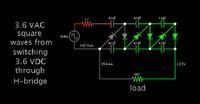T
treez
Guest
Hello,
I have to make a Power supply which must provide Vout = 10V and Iout = 15mA
Vin is a 3v6 battery.
The chief engineer asked me how i would do this..........so i said i would either use a monolithic boost converter or a charge pump.
...but the chief engineer replied that actually i should use a bias power supply based on a "relaxation oscillator"
.....i am not sure what they meant.....do you know what it means?
I have to make a Power supply which must provide Vout = 10V and Iout = 15mA
Vin is a 3v6 battery.
The chief engineer asked me how i would do this..........so i said i would either use a monolithic boost converter or a charge pump.
...but the chief engineer replied that actually i should use a bias power supply based on a "relaxation oscillator"
.....i am not sure what they meant.....do you know what it means?
